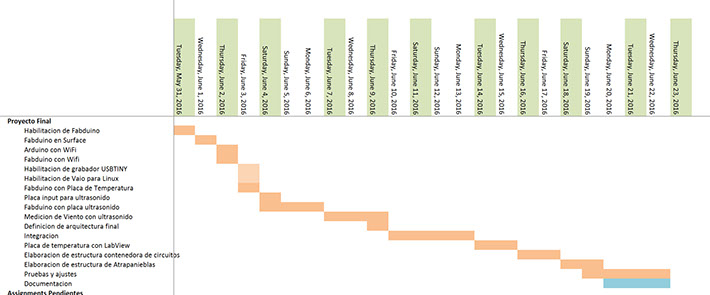Research Station for Water From Air Machine (Dew Point Monitoring System for Fogcachers)
What will it do?
It will measure temperature and humidity in the point where Water From Air Machine is located. It ll allow the designers of fogcatchers to establish the best place to put a fogcatcher or another device to condense water from the air.
Many projects are done beforehand, reading temperature, humidity and other variables.
In the subject of harvesting fog some custom features are needed:
People in charge of installing the fog catchers, or researchers are assessing the best places to install fog catchers, which involves measuring the water available in the fog . This is called the ‘liquid water flux’. It is also important to determine the frequency and duration of foggy periods.
who's done what beforehand?
CDA-UC and Massachusetts Institute of Technology (MIT)
The researchers are working on different ways of reducing the costs of fogcatchers. Assessing the best places to install fog catchers, which involves measuring the water available in the fog and wind velocity. This is called the ‘liquid water flux’. It is also important to determine the frequency and duration of foggy periods.
The idea is to use a wireless sensor network to make a liquid water flux map.
What materials and components will be required?
- MDF board to mill the box.
- Fabduino
- Temperature/Humidity board
- Conextion cables
- Wood or MDF for a fogcatcher structure
Where they will come from?
All material exists in Fab Lab stock
Some electronics are provided by online electronics sellers.
How much it will cost?
The cost of the MDF board and wood for fogcatcher is less than $ 50.
The cost of each electronic board is less than $10, Its expected to use about 5 boards, so the total cost of the electronics will be below $ 50
The total cost of the goal will be less than 100€.
What parts and systems will be made?
The box, the circuits, the fogcagtcher.
What processes will be used?
- Computer aided design to design the fog-catcher structure
- Electronics production & electronics design for the boards
- Computer-controlled machining to create the goal structure
- Embedded programming for the code of the sensors
- Input devices (to measure from ultrasonic sensor)
- Output devices (the display of the position to aim at
- Networking and communications
- Interface and application programming, for the computer application
What tasks need to be completed?
In previous week assignment I design and build some parts of the project, so a lot of work is already done. At this moment I have remaining:
Fog-catcher new design.
Mill and solder all the sensor boards needed
Build the code of the computer application for result calculations and sensor management
What questions need to be answered?
There are still some problems to be solved, as the data exchange between sensors and computer, what to do when nothing is detected, and so on. Anyway, at this moment I have a big concern before having the full system running: how to avoid interference between the sensors.
Using ultrasonic sensors make very easy and fast the development, but they have a big problem, and it is that as I am using a lot of identical ultrasonic sensors, they will interference themselves and mistake the measurements. I need to find a way to synchronize them and avoid that.
What is the schedule?
At this moment I have 3 weeks remaining to be able to present it on June 22th, so:
